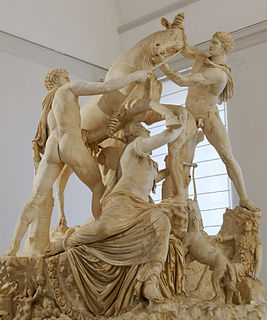
The Farnese Bull, formerly in the Farnese collection in Rome, is a massive Roman elaborated copy of a Hellenistic sculpture. It is the largest single sculpture yet recovered from antiquity. Along with the rest of the Farnese antiquities, it has been since 1826 in the collection of the Museo Archeologico Nazionale Napoli in Naples, inv. no. 6002, though in recent years sometimes displayed at the Museo di Capodimonte across the city. The sculpture in Naples is much restored, and includes around the base a child, a dog, and other animals not apparently in the original composition, which is known from versions in other media.

The National Archaeological Museum of Naples is an important Italian archaeological museum, particularly for ancient Roman remains. Its collection includes works from Greek, Roman and Renaissance times, and especially Roman artifacts from nearby Pompeii, Stabiae and Herculaneum. It was formerly the Real Museo Borbonico.

The Astronomical Observatory of Capodimonte is the Neapolitan department of Istituto Nazionale di Astrofisica, the most important Italian institution promoting, developing and conducting scientific research in the fields of astronomy, astrophysics, and space science.

Museo di Capodimonte is an art museum located in the Palace of Capodimonte, a grand Bourbon palazzo in Naples, Italy. The museum is the prime repository of Neapolitan painting and decorative art, with several important works from other Italian schools of painting, and some important ancient Roman sculptures. It is one of the largest museums in Italy.

Piscinola, or Piscinola-Marianella, is a northern suburb of Naples, Italy, with a population of ca. 20,000. It is bordered to the north by the Scampia district, north-west with the municipality of Mugnano of Naples, on the west by the Chiaia district, to the south with the district of San Carlo all'Arena and east with the district Miano.

Capodimonte porcelain is porcelain created by the Capodimonte porcelain manufactory, which operated in Naples, Italy, between 1743 and 1759. Capodimonte is the most outstanding factory for early Italian porcelain, the Doccia porcelain of Florence being the other main Italian factory. Capodimonte is most famous for its moulded figurines.

Sant'Aspreno ai Crociferi is a church in the neighborhood of San Carlo all'Arena, Naples, southern Italy. It is dedicated to Saint Aspren.
Capodimonte is an Italian placename. It may refer to:

The Gibran Museum, formerly the Monastery of Mar Sarkis, is a biographical museum in Bsharri, Lebanon, 120 kilometres (75 mi) from Beirut. It is dedicated to the Lebanese writer, philosopher, and artist Kahlil Gibran.
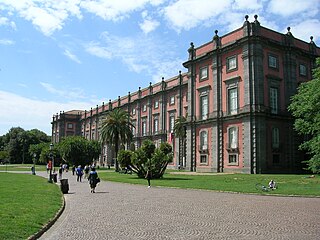
The Royal Palace of Capodimonte is a grand Bourbon palazzo in Naples, Italy, formerly the summer residence and hunting lodge of the kings of the Two Sicilies, and was one of the two Royal Palaces in Napoli. It today houses the National Museum of Capodimonte and art gallery of the city. "Capodimonte" means "top of the hill", and the palace was originally just outside the city, which has now expanded to surround it, and somewhat cooler than the city in summer.
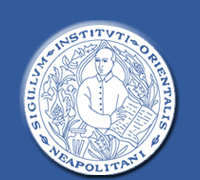
University of Naples "L'Orientale", is a university located in Naples, Italy. It was founded in 1732 and is organized in 4 Faculties. It is the oldest school of Sinology and Oriental Studies of the European continent and the main university in Italy specialized in the study of non-European languages and cultures, with research and studies agreements with universities from all over the world. It is one of the most prestigious universities in the world regarding Asian cultures and languages.

The Second Municipality is one of the ten boroughs in which the Italian city of Naples is divided. It is the littlest municipality per surface.

The Third Municipality is one of the ten boroughs in which the Italian city of Naples is divided.

The Sixth Municipality is one of the ten boroughs in which the Italian city of Naples is divided. It is the largest municipality per surface.
Museum Correale is a museum in Sorrento in the south of Italy.

The following is a timeline of the history of the city of Naples. The Naples area has been inhabited since the Neolithic period. The earliest historical sources in the area were left by the Myceneans in the 2nd millennium BC. During its long history, Naples has been captured, destroyed and attacked many times. The city has seen earthquakes, volcanic eruptions, foreign invasions and revolutions.
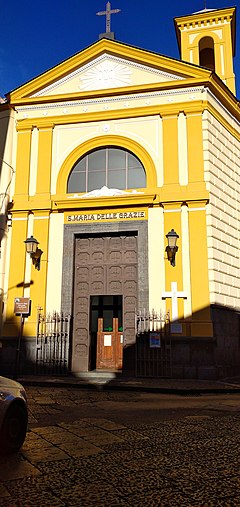
Santa Maria delle Grazie a Capodimonte is a church located in via Bosco in Capodimonte in Naples, Italy.
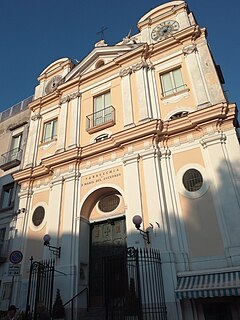
Santa Maria del Soccorso all’Arenella is a parish church, located in the Piazzetta Arenella in the Rione of Arenella of Naples, Italy. Tradition holds that this church was the parish church for Salvatore Rosa in Naples.

Santissima Trinità delle Monache is a large former monastery and church in central Naples, Italy; it now serves as a military hospital. It is located in the Spanish Quarter of the city.



















